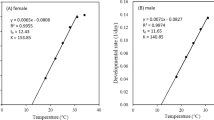Abstract
Opius concolor Szépligeti is a parasite ofBactrocera oleae (Gmelin) and other Tephritid flies. Its development rate was studied with the Sharpe-DeMichele mathematical model, modified by Schoofieldet al. (1981), using the S.A.S. program elaborated by Wagneret al. (1984). This program chose a four parameter poikilotherm model with high temperatures inhibition. Duration of parasitoid development at seven constant temperatures ranged from 14.6±1.7 days at 28°C (males), to 77.2±5.5 days at 15°C (females). Male development was consistently found to be shorter than that of females. Low development threshold and degree-days needed to complete total development were determined with the “Regression Line” and “Thermal Summation” methods. Values (cumulated for both sexes) were found to be respectively 11.7°C and 11.8°C (low threshold), 255.9 and 251.9±16.8 days (thermal constant). Considerations on the possibility of establishingOpius concolor in northern and central Italian regions are discussed.
Résumé
Opius concolor est un parasitoïde deBactrocera oleae (Gmelin) et d’autres tephritidés. Sa vitesse de développement a été étudiée avec le modèle mathématique de Sharpe-DeMichele, modifié par Schoofield (1981), utilisant le programme S.A.S. élaboré par Wagneret al. (1984). Ce programme a choisi un modèle à quatre paramètres pour les poikilothermes avec inhibition aux températures élevées. La durée de développement du parasitoide sous sept différentes températures constantes est comprise entre 14,62±1,69 jours à 28 °C (mâles) et 77,25±5,5 jours à 15 °C (femelles). Le développement des mâles est nettement plus court que celui des femelles. Le seuil de développement et les degrés-jours nécessaires à un développement complet étaient déterminés par les méthodes de la « ligne de régression » et de la somme thermale. Les valeurs (pour les deux sexes cumulés) étaient respectivement de 11,7 °C et de 11,8 °C (seuil bas), 255,9 et 251,9 ± 16,77 jours (constante thermale). La possibilité d’acclimaterOpius concolor dans le nord et le centre de l’Italie est discutée.
Similar content being viewed by others
References
An-Ly Yao. — 1986. Ring like structure: a mortality factor due toOpius concolor (Hym.: Braconidae) besides parasitism onAnastrepha suspensa (Diptera: Tephritidae). (Cavalloro R., ed.)Second International Symp. fruit flies (Crete, Sept. 1986): 511–514.
Arambourg, Y. — 1986. Traité d’Entomologie Oléicole. Conseil Oleicole International. Juan Bravo, 10-2° — Madrid, Espagne.
Biliotti, E. &Delanoue, P. — 1959. Contribution a l’étude biologique d’Opius concolor Szépl. (Hym. Braconidae) en élevage de laboratoire. —Entomophaga, 4, 7–14.
Cavalloro, R. &Girolami, V. — 1969. Miglioramenti nell’allevamento in massa diCeratitis capitata Wiedemann (Diptera, Trypetidae). —Redia, 51, 315–327.
Crovetti, A., Quaglia, F., Loi, G., Rossi, E., Malfatti, P., Chesi, F., Conti, B., Belcari, A. &Raspi, A. — 1982. Influenza di temperature ed umidità sullo sviluppo degli stadi preimmaginali diDacus oleae Gmelin. —Frust. Entom., n.s., 5, 133–166.
Fenili, G. &Pegazzano, F. — 1971. Contributo alla conoscenza dei parassiti delDacus oleae Gmel. Ricerche eseguite in Toscana negli anni 1967 e 1968. —Redia, 52, 1–29.
Feron, M. — 1952. Observation sur le parasitisme deCeratitis capitata Wied. dans le sous Marocain. —Rev. Pathol. vég. Entomol. Agric. France, 31, 99–102.
Jannone, G. &Binaghi, G. — 1959. Primi esperimenti di introduzione in Liguria di un endofago della mosca delle olive:Opius concolor Szépl. (=O. siculus Mon.) (Hymenoptera: Braconidae) della Sicilia. —Boll. Lab. Entomol. Agr. Portici, 17, 89–123.
Jimenez, A., Castillo, E. &Lorite, P. — 1990. Supervivencia del himenóptero bracónidoOpius concolor Szep. Parásito deDacus oleae Gmelin en olivares de Jaén. —Bol. San. Plagas, 16, 97–103.
Kapatos, E., Fletcher, B. S., Pappas, S. &Laudeho, Y. — 1977. The release ofOpius concolor andO. concolor Var.Siculus (Hymenoptera: Braconidae) against the spring generation ofDacus oleae (Dipt: Trypetidae) on Corfu. —Entomophaga, 22, 265–270.
Loni, A. — 1994. Studi bio-etologici sugli entomofagi della Mosca dell’olivo. Ph. D. dissertation, University of Pisa.
Marchall, P. — 1910. Sur un Braconide nouveau, parasite duDacus oleae. —Bull. Soc. Ent. Fr., 243–244.
Monaco, R. &Nuzzaci, G. — 1970. Osservazioni slla possibilità di svernamento in Puglia diOpius concolor Szépl. (Hymenoptera — Braconidae). —Entomologica, 6, 181–194.
Monastero, S. — 1931. Un nuovo parassita endofago della mosca delle olive trovato in Altavilla Milicia (Sicilia) — Fam. Braconidae, Gen.Opius. Atti R. Acc. Sc. Lett. ed Arti di Palermo, XVI (3).
Monastero, S. — 1969. Nuove osservazioni sulla biologia dellaCarpomyia incompleta Becker. —Boll. Ist. Ent Agr. e Oss. Fitop. di Palermo, 7, 147–157.
Monastero, S. &Delanoue, P. — 1966. Lutte biologique expérimentale contre la mouche de l’olive (Dacus oleae Gmel.) au moyen d’Opius concolor Szépl.siculus Mon. dans les îles Eoliennes (Sicilie) en 1965. —Entomophaga, 2, 411–432.
Morales-Ramos, J. A. &Cate, J. R. — 1993. Temperature-dependent developmental rates ofCatolaccus grandis (Hymenoptera: Pteromalidae). —Environ. Entomol., 22, 226–233.
Orr, C. J. &Obrycki, J. J. — 1990. Thermal and dietary requirements for development ofHippodamia parenthesis (Coleoptera: Coccinellidae). —Environ. Entomol., 19, 1523–1527.
Raspi, A. &Loni, A. — 1994. Alcune note sull’allevamento massale diOpius concolor Szépligeti (Hymenoptera: Braconidae) e su recenti tentativi d’introduzione della specie in Toscana e liguria. —Frust. Entomol., n.s., 30, 135–145.
Schoolfield, R M., Sharpe, P. J. H. &Magnuson, C. E. — 1981. Nonlinear regression of biological temperature-dependent rate models based on absolute reaction-rate theory. —J. Theor. Biol., 64, 649–670.
Silvestri, F. — 1916. Sulle specie di Trypaneidae (Diptera) del genereCarpomyia dannose ai frutti diZiziphus. —Boll. Lab. Zool. Gen. e Agr. Portici, 11, 170–182.
Wagner, T. L., Wu, Sharpe J. H., Schoolfield, R. M. &Coulson, R. N. — 1984. Modeling insect developmental rates: a literature review and application of a biophysical model. —Ann. Entomol. Soc. Am., 77, 208–225.
Wigglesworth, V. B. — 1972. The principles of insects physiology, 7th ed.Chapman and Hall, London.
Author information
Authors and Affiliations
Rights and permissions
About this article
Cite this article
Loni, A. Developmental rate ofOpius concolor (HYM.: Braconidae) at various constant temperatures. BioControl 42, 359–366 (1997). https://doi.org/10.1007/BF02769829
Received:
Accepted:
Published:
Issue Date:
DOI: https://doi.org/10.1007/BF02769829




